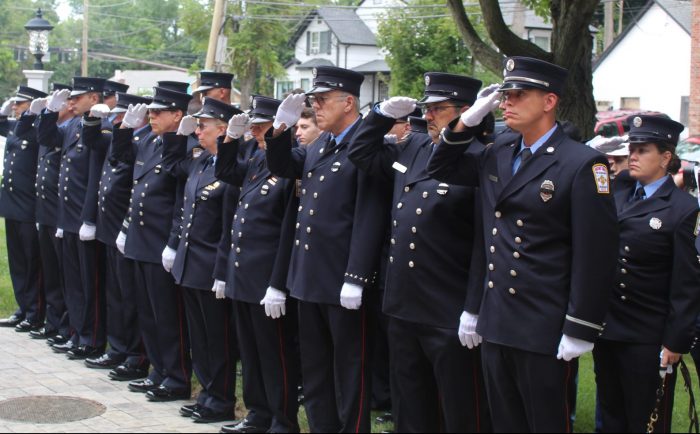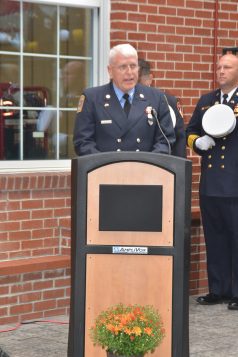Port Jeff mayor estimates $3M for upper wall, trustees debate erosion mitigation strategy at village country club
The Port Jefferson Village Board of Trustees is approaching a meaningful vote to decide the future of the Port Jefferson Country Club.
PJCC is a village-owned property. In a two-phased initiative, the board is actively responding to the harmful effects of coastal erosion at East Beach. Construction of a lower retaining wall is ongoing after a 4-1 vote under a previous composition of the board of trustees.
Now the board is looking upland, where erosion has encroached dangerously upon the PJCC clubhouse. Without remediation, the clubhouse could fall off the cliff within years.
Weighing its options, the board must soon decide whether to invest in preserving the existing clubhouse by adding a steel wall or retreating inland.
A battle against time and nature‘We’re already at a point where we’re playing beat the clock. We’ve lost a tremendous amount of material, and that is something we have to take into consideration.’ — Margot Garant
In an exclusive interview with Mayor Margot Garant, she provided her initial estimates for the cost of the upper wall.
“We’re estimating approximately another $3 million for that upper wall project,” she said. “The lower wall was a more complicated project because of the steel, rock and revegetation of the entire slope. The upper wall is really only steel and vegetation.” Bids for this project are still out but are due by Oct. 7, when the village will receive its final estimate.
Garant acknowledged the severe economic and environmental constraints working against the village. The construction cost index is forecast to see a 14.1% year-to-year increase by Dec. 31. While the cost of building materials skyrockets, inflation is at its highest point in four decades.
Meanwhile, the cliff erosion is rapidly closing in on the clubhouse. For these reasons, Garant feels a sense of urgency to approve the upper wall if the village board favors that option.
“I think economic factors … plus Mother Nature are all kind of not working to our advantage at this point in time,” she said. “We’re already at a point where we’re playing beat the clock. We’ve lost a tremendous amount of material, and that is something we have to take into consideration — the pros and cons and the risk factors.”
While the mayor appears committed to quick remediation, the board has no unanimous consensus. Trustee Rebecca Kassay was the lone dissenter on the lower wall vote, citing a lack of public input into the final determination.‘As community leaders, it’s our duty to look at the realities in front of us and serve the community accordingly.’ — Rebecca Kassay
If presented with a similar vote on the upper wall, Kassay said she would vote “no” again. “My position is still the same,” she said. “I cannot, in good conscience, vote for another multimillion dollar project without having the residents of Port Jefferson show their support or rejection for it.”
Drawing from her background in environmental advocacy, Kassay believes there are viable alternatives to the upper wall. While the burgeoning science of coastal erosion mitigation may be daunting, according to her, exploring these options may be in the village’s long-term interest.
“Adopting new strategies and technologies can be very nerve-racking,” the trustee said. “It’s quite upsetting but, as community leaders, it’s our duty to look at the realities in front of us and serve the community accordingly.”

This week, a local climate expert presented some of her findings to the Port Jeff community. During a Greater Port Jefferson Chamber of Commerce meeting Tuesday, Sept. 27, Elizabeth Hornstein, a New York State Sea Grant sustainable and resilient communities specialist for Suffolk County, explained the pending threat of sea-level rise and intensifying storms on coastal communities.
Hornstein’s presentation stressed the need for community planning and resiliency. She advised that addressing the issue of erosion near the country club would require a communitywide assessment of its environmental priorities.
“I think the community as a whole has to decide what is most important,” she said. “Is the country club an asset that is very important to the community? What else in the community, though, is also very important that you may want to protect?” She added, “I think it’s a tricky situation, and it’s hard to make those calls.”
Reimagining PJCC‘I would like to see more of a country club atmosphere up there, and I’m not sure we’re getting it with the existing building.’
— Stan Loucks
Trustee Stan Loucks remains undecided whether he will support the upper wall. Like Kassay, Loucks has expressed support for putting the matter out for a public referendum. However, he suggests the board should tie an upper wall proposal to a plan for reinvigorating the country club.
Critics of saving the clubhouse have cited examples of village officials referring to the clubhouse as “underutilized.” Joining these detractors, Loucks hopes for greater use of the country club’s available amenities.
“I would like to see more of a country club atmosphere up there, and I’m not sure we’re getting it with the existing building,” he said. “I want to see what it’s going to cost to put an upper wall in there, and I want to see what it would cost to perhaps build a new building.”
Trustee Lauren Sheprow campaigned earlier this year on a platform of protecting the clubhouse. In an email statement, she referred to the facility as “one of Port Jefferson’s finest assets.”‘I would also like to hear how this would factor into a more comprehensive long-term strategy for the country club campus.’
— Lauren Sheprow
In her short tenure on the village board, Sheprow has already resurrected the Parks and Recreation Advisory Council. The newly elected trustee said this council will work to bolster recreational activities at the clubhouse.
“I am hopeful that our new Parks and Recreation Advisory Council will help to build and cultivate a concept, which will be on the agenda for our first meeting in October,” Sheprow said. “We would also like to create more recreational opportunities over the winter months.” She added that new racket sports amenities might provide even more avenues for recreational use.
As the board awaits cost estimates for the upland projects, Sheprow intends to evaluate both options thoroughly before making a final judgment. “I would like to be able to do a walkthrough of the proposed solutions and hear from those who have designed them,” she said, adding, “I would also like to hear how this would factor into a more comprehensive long-term strategy for the country club campus.”
Garant said residents could expect at least one more work session in the coming weeks for the upland proposals. After that, it remains unclear whether these projects will go out for a public vote.
“I think the Board of Trustees will make that decision as soon as possible if we’re moving forward [with the upper wall],” the mayor said. “And if we’re not moving forward, some of the other retreat plans will take time because the retreat plan means that we’re abandoning the facility.”
With respect to a possible referendum, she added, “When we have that price point, we can have that discussion as a board. I’m not sure I’m in agreement with that as that was something we should have discussed when we passed the resolution for the $10 million bond.”
Deputy Mayor Kathianne Snaden could not be reached for comment on this story.
















































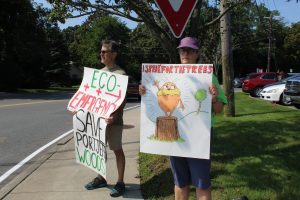 Despite receiving objections from EcoLeague, the Audubon Society and multiple citizens, Mather Hospital went through with plans to clear its forest area. “They kind of just plowed ahead because I think they were pretty sure that the [village] planning board would approve it,” Fils-Aime said. [See The Port Times Record’s June 16 story, “
Despite receiving objections from EcoLeague, the Audubon Society and multiple citizens, Mather Hospital went through with plans to clear its forest area. “They kind of just plowed ahead because I think they were pretty sure that the [village] planning board would approve it,” Fils-Aime said. [See The Port Times Record’s June 16 story, “ EcoLeague is also concerned that the cutting down of the woods will harm local species of animals and that Mather Hospital’s construction of a parking lot will act as a “heat sink,” raising local temperatures.
EcoLeague is also concerned that the cutting down of the woods will harm local species of animals and that Mather Hospital’s construction of a parking lot will act as a “heat sink,” raising local temperatures.



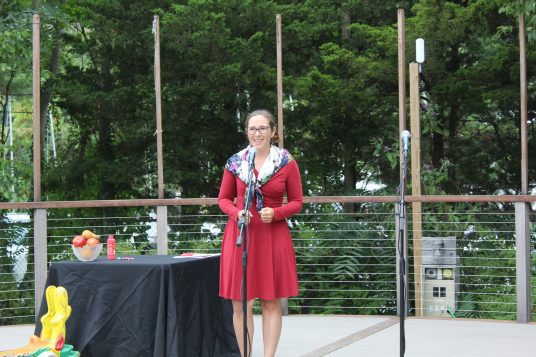

























































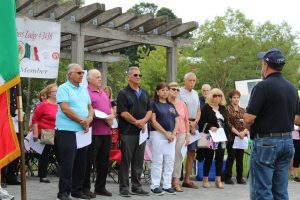 Anthony Rotoli Jr., president of the lodge, explained the intent of the memorial service. For lodge members, it is an annual reminder of the sacrifices and heroism of first responders who risked their lives in the line of duty. It is also a way to honor the many lost on that fateful occasion.
Anthony Rotoli Jr., president of the lodge, explained the intent of the memorial service. For lodge members, it is an annual reminder of the sacrifices and heroism of first responders who risked their lives in the line of duty. It is also a way to honor the many lost on that fateful occasion.  Larry Johnston, one of the attendees, served with Joseph Vigiano as a patrol officer. He remembers Joseph’s dedication to his profession and his commitment to public service.
Larry Johnston, one of the attendees, served with Joseph Vigiano as a patrol officer. He remembers Joseph’s dedication to his profession and his commitment to public service.